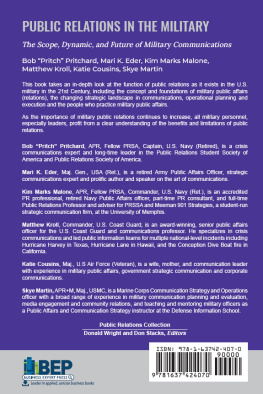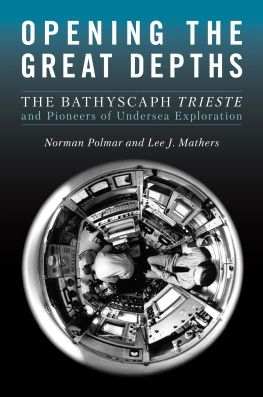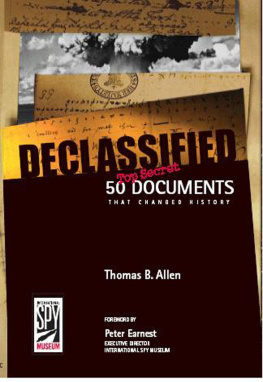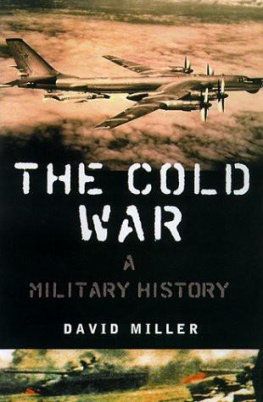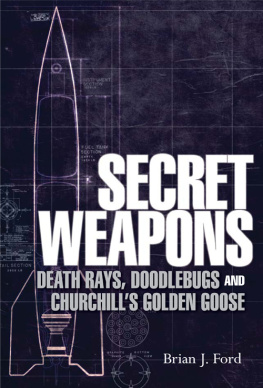GPS
DECLASSIFIED
GPS
DECLASSIFIED
From Smart Bombs to Smartphones
Richard D. Easton and Eric F. Frazier
Foreword by Rick W. Sturdevant

2013 by Richard D. Easton and Eric F. Frazier
Foreword 2013 by the Board of Regents of the University of Nebraska
Letter from Arthur C. Clarke in reprinted by permission of the author and the authors agents, Scovil Galen Ghosh Literary Agency, Inc.
All rights reserved. Potomac Books is an imprint of the University of Nebraska Press.
Manufactured in the United States of America.

Library of Congress Cataloging-in-Publication Data
Easton, Richard D.
GPS declassified: from smart bombs to smartphones / Richard
D. Easton and Eric F. Frazier; foreword by Rick W. Sturdevant.
pages cm
Includes bibliographical references and index.
ISBN 978-1-61234-408-9 (cloth: alk. paper)
1. Global Positioning SystemHistory. I. Title.
G109.5.E37 2013
910.285dc23 2013023507
Set in Lyon Text by Laura Wellington.
Designed by J. Vadnais.
To my father, Roger Easton, for his support and kind assistance in creating a field for me to write about; to my mother, Barbara Easton, for fostering in me a love of history; and to my wife, Kathleen, for her support and assistance.
RICHARD D. EASTON
To my father, Arvel Frazier, who gave me his love of geography and history; to my mother, Isabel Frazier, who gave me her penchant for accuracy and thoroughness; and to my wife, Margie, whose support and encouragement made it possible for me to undertake this project.
ERIC F. FRAZIER
Contents
by Rick W. Sturdevant
Illustrations
Foreword
For one who has been writing a portion of the official history of Global Positioning System (GPS) operations since the 1980s, it is startling to realize that young people entering college in 2013 have never known a world without GPS. Even those who are aware of the systems transparent presence on their personal phone devices, in their daily business transactions, or amid their recreational activities undoubtedly take its benefits for granted. It would be surprising if more than a few could explain, at even a rudimentary level, how this amazing space-based positioning, navigation, and timing (PNT) system works. How many know GPS is the worlds only global utility? Who stops to remember that its signals are available free of charge to anyone with a GPS receiver?
Here, at last, Richard Easton and Eric Frazier present in plain, simple language how a PNT system originally developed for military purposesone that Air Force Space Command continues to operate and maintainbecame essential for countless civil and commercial activities around the world. The authors deftly place the concept and development of GPS within two broader historical contexts: navigation and robotic spaceflight. Their description of the dissimilar problems that compelled visionaries in each of the military services to pursue a three-dimensional positioning and navigation system substantiates the adage, sometimes attributed to Plato, that necessity is the mother of invention.
On the way to fostering what emerged as GPS, however, ample participation occurred to justify multiple paternal claims. Eventually, different individuals garnered high-level recognition based on, and bolstering, their respective claims. One (Roger Easton) received the 2004 National Medal of Technology from President George W. Bush. The National Academy of Engineering awarded two others (Ivan Getting and Brad Parkinson) the 2003 Charles Stark Draper Prize. All three, in recognition of their seminal GPS roles, became inductees to the National Inventors Hall of Fame. In 2012 the National Space Club named the same trio among the GPS Originator Team that received the prestigious Dr. Robert H. Goddard Memorial Trophy. Numerous others also contributed, without fanfare or subsequent recognition, to the conceptualization and development of GPS.
Easton and Frazier explore the debatable parentage of GPS through sources previously ignored by or unavailable to other scholars. While not the definitive history of the origins of GPS and its place in the centuries-old panoply of navigational systems, their study certainly advances our knowledge of the who, what, when, where, why, and how behind this amazing technological accomplishment. This book represents a solid foundation upon which future scholars can build their research and writing about GPS, or what has become more broadly identified as global navigation satellite system (GNSS) technology.
Beyond the origin of GPS and how it works, these authors deliver an impressive survey of the historical evolution of GPS applications among military, civil, and commercial users, not to mention private individuals. Although certainly not all-inclusive, their astounding coverage of the many ways in which people rely on precise PNT from outer space boggles the mind. When the authors describe the systems vulnerability to interference, whether intentional or natural, the potentially devastating military, societal, economic, and political effects of GPS disruption take on sinister proportions.
Whenever historians venture into the future, based on their understanding of the past and their perception of the present, they generally fare no better than nonhistorians. All confront largely incomprehensible terrain. Nonetheless, Easton and Frazier dare to conclude their GPS study with an overview of possibilities. Indeed, advocates of vector analysis in history might perceive that these two authors discern probabilities based on chronological patterns or trendsscientific, technological, economic, political, military, and social. Still, they recognize that if history teaches us anything, it is to remain watchful for unexpected twists and unanticipated turns. That is precisely what keeps past, present, and future particularly interesting and occasionally controversial, as the following narrative demonstrates.
Rick W. Sturdevant, PhD
Deputy Director of History
HQ Air Force Space Command
Acknowledgments
The authors would like the thank the following people who shared information through interviews or correspondence, provided documents or images, read portions of the manuscript, and offered suggestions or otherwise aided the research and writing of this book:
Roy Anderson (now deceased), radio-navigation pioneer at General Electric, and his wife, Gladys; Jonathan Betts, senior curator of horology, Royal Observatory, Greenwich, UK; Veronique Bohbot, PhD, professor of psychiatry at McGill University and Douglas Institute in Montreal; Walter Boyne, author/ historian; Michael Buckley, public information officer, the Johns Hopkins University Applied Physics Laboratory; Alan Cameron, publisher and editor-in-chief, GPS World; Glen Gibbons, editor, Inside GNSS; David Gosch, senior public relations specialist, Rockwell Collins; Mike Gruntman, professor of astronautics, University of Southern California; R. Cargill Hall, historian emeritus, National Reconnaissance Office; Robert Kern, president, Kernco Inc., and builder of atomic frequency standards for the GPS program; Jason Kim, senior advisor, National Coordination Office for Space-Based PNT; Chester Kleczek (now deceased), former engineer at Naval Air Systems Command, who was the original program manager and sponsor of Timation; Arthur McCoubrey, cofounder of Frequency and Time Systems, which built early atomic frequency standards for the GPS program; Keith D. McDonald, former scientific director of the Navigation Satellite Executive Steering Group and executive secretary of the Defense Navigation Planning Group; Kimberly Morgan, corporate communications, Texas Instruments; Dian Moulin, daughter of Navy captain David Holmes (deceased); Harold Rosen, former vice president at Hughes Aircraft; Dava Sobel, author; Harry Sonnemann, former chairman of the Navigation Satellite Executive Steering Group; Rick Sturdevant, deputy command historian, U.S. Air Force Space Command, Peterson AFB, Colorado Springs, Colorado; Martin Votaw, former engineer at the Naval Research Laboratory; Phil Ward, president, Navward GPS Consulting; and current or former Naval Research Laboratory staffers Jonna Atkinson, Jamie Baker, Ron Beard, James Buisson, Dean Bundy, Gayle Fullerton, Lee Hammarstrom, Vijay Koweth, Thomas McCaskill, Kathy Parrish, Leo Slater, Richard Thompson, Jim Tugman, Joe White, Robert Whitlock, and Peter Wilhelm.
Next page


